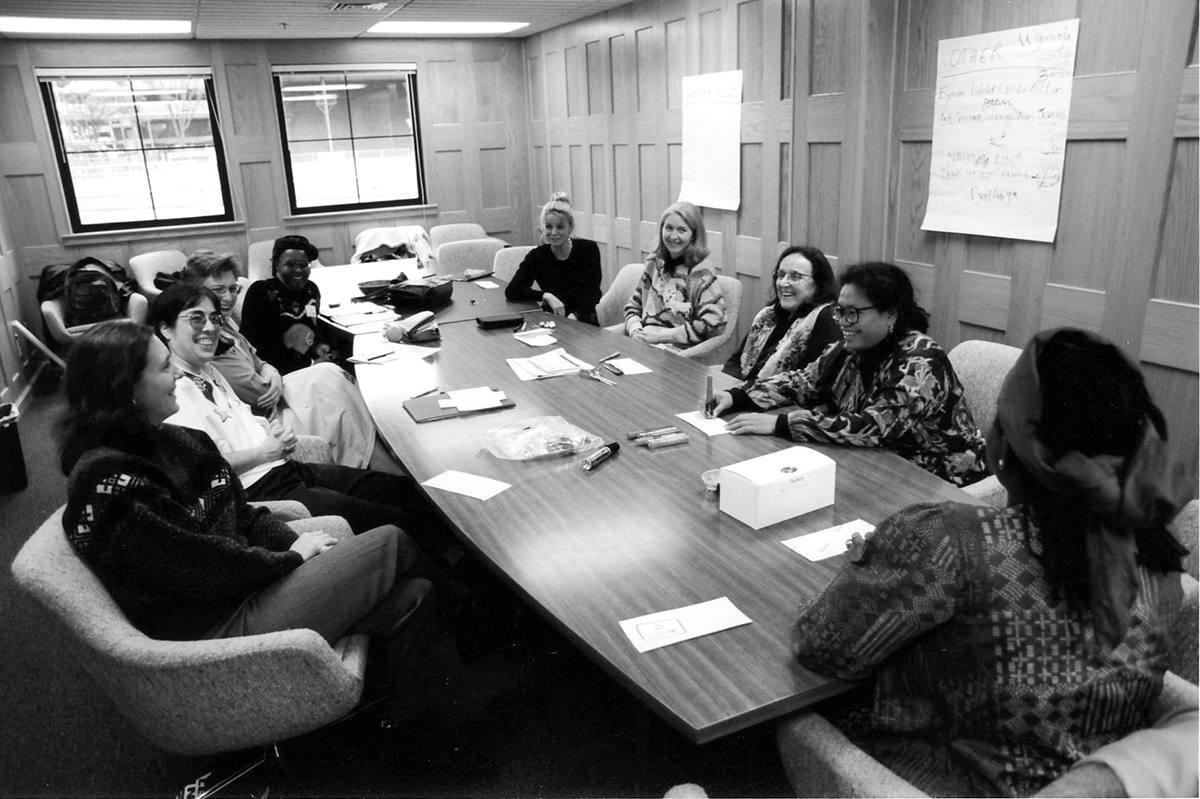
by Jenée Wilde, PhD candidate, English
In 1994, the Center for the Study of Women in Society (CSWS) launched a bold new vision—to foster scholarly collaboration through research interest groups, or RIGs. While the center had primarily funded individual research in earlier decades, the RIG model was designed to support a variety of intellectual and social connections among scholars working on gender in broadly related fields.
The idea for RIGs developed out of the center’s long-range planning process, launched in 1991 when Sandra Morgen arrived at the University of Oregon.
“I came here because I had a very political sense of feminist scholarship,” Morgen said. “I took the job [as CSWS director] largely because I saw so much possibility with the combination of a strong group of feminist scholars and the base funding from the endowed centers. If there was anywhere a vision of intersectionality and collaboration would work, I thought it would be at a place with resources.”
Building on her experiences with other women’s research centers, Morgen envisioned an expansive approach to research at CSWS that drew connections between individual and collective efforts. “I had a vision of where I wanted the center to go,” she said, “but I realized that if we didn’t get a general buy-in for that vision, it wasn’t going to work.”
The new process began with a year of “Research Conversation” events where faculty from a variety of disciplines came together to discuss issues involved in doing feminist research. “Conversation” topics included research praxis beyond the classroom, the use of autobiography and narrative in research, the pitfalls and possibilities of doing collaborative research, and the integration of gender, race, and class into the research process.
While the approach achieved some refinement of the center’s research direction, Morgen felt a stronger process was still needed.
“If we were going to become known as a key research center on campus, we needed to build an identity as more than funding individual research,” Morgen said. “We decided to build the new vision for CSWS from the ground up by not predetermining what the areas of strength or interests were. We wanted to know, what could CSWS generate in terms of collaborative projects and research?”
From 1992 to 1994, planning committees worked to develop group research opportunities that allowed both interdisciplinary work and research within a specific discipline, without being mutually exclusive. A key concern was how to maintain a vibrant community of scholars and affiliates while also focusing in-house research activities into one or two key areas. Another concern was including arts and humanities scholarship in the new rubric since, historically, CSWS had been oriented more toward the social sciences.
During two years of strategic planning, two primary approaches took shape: CSWS-housed research initiatives—beginning with an endowment for the Women in the Northwest Initiative in 1992—and a new model of “substantive interest groups.”
In September 1994, the center hosted a fall retreat to “jump start” new interest groups that would meet throughout the year on a variety of projects. “The emerging research interest groups will serve as the essential building blocks of CSWS,” Morgen wrote in the fall newsletter, “replacing some of our old committee structures, previously the primary route for involvement by affiliates with the center. . . . By the end of the retreat we hope to be closer to deciding those research areas having potential to evolve as ‘hubs’ or connectors for us as scholars, and/or to attract external funding to be funneled through CSWS.”
In fact, RIGs became an important intellectual resource for feminist scholars on campus in the social sciences and humanities. Affiliates Dianne Dugaw (professor, English), Amanda Powell (senior lecturer, Romance Languages, Spanish, and Latin American studies), and Barbara Altmann (vice provost of Academic Affairs and professor, Romance Languages and French) recalled the fall retreat in an article coauthored for the center’s Fall/Winter 2003 newsletter:
It was in 1994 that all CSWS affiliates interested in the RIG model gathered for an enormous planning meeting in Gerlinger Hall, during which we broke into “focus groups” for discussion. Of six or seven groups, one offered a humanities rubric. A huge circle of people convened in a back room behind the kitchen, thinking about “arts and literatures.” It included scholars and practitioners of literatures, dance, music, art, and history, all interested in examining how our present moment constructs views of the past. After that first meeting, we began our collaborative process with an initial application to CSWS for funding for a RIG interested in “Reclaiming the Past” in women’s and gender studies.
In spring 1995, the center’s new Research Development Grants program awarded $30,000 to several new RIGs, including Reclaiming the Past; Women’s Health and Development; Women, Work, and Economic Restructuring; Women in Vietnam; Women and the Environment; RIG on the Right; and Rationality, Intuition, and Gender in Science and Other Creative Processes (RIG Squared). During the next academic year, these groups organized conferences, guest lectures, public forums, and pedagogical workshops; wrote external grant funding proposals; and explored collaborative relationships with other scholars and organizations.
By 1997, the RIG process had yielded two more major program initiatives: the Feminist Humanities Project, which grew out of the extraordinary success of the Reclaiming the Past RIG, and the Women’s Health and Aging Research Initiative.
Over the last twenty years, RIGs have served many purposes for those involved. Some RIGs have been ephemeral, meeting a need for connection and intellectual community at a given moment, but many have had lasting impacts on the research communities of UO and beyond.
In 1998, for example, the Women and the Environment RIG was awarded a $250,000 Rockefeller Foundation grant to study the intersections of gender, science, and the sacred. Not only was it the first Rockefeller grant received by UO, it also was the first to be awarded in the humanities in the state. In 2001, the Women’s Health and Aging Research Initiative received just over $1 million from the National Institutes of Health for two studies on the acceptability of the vaginal diaphragm among women for protection against pregnancies and some sexually transmitted diseases.
Some groups that started as RIGs have developed into their own centers, such as the Center for Latino/a and Latin American Studies and the Wired Humanities Projects. Others have expanded in scope into major partnerships, such as the Fembot Collective. In the last three years, Fembot has grown into an international collaboration among faculty, graduate students, media producers, artists, and librarians that promotes research on gender, new media, and technology and supports an open peer reviewing process for their online journal.
Some RIGs have simply remained RIGs because the flexible model, open to the shifting needs and interests of group members, works for the people involved. Such is the case for the center’s longest standing RIG: the Social Sciences Feminist Network (SSFN).
Kari Norgaard, now a UO associate professor of sociology and environmental studies, was a graduate student when the SSFN was founded in 2000. “There were a handful of us,” she said. “We were so compelled by the idea of having informal contact with one another in a peer networking space for us as graduate students.”
The RIG was conceived at a coastal retreat for a discussion of feminist theory. Joan Acker (Professor Emerita, Department of Sociology) described the event for the Spring 2003 newsletter: “[The students] discovered that they knew little about each other and were isolated in individual worlds of academic work. Fortunately, CSWS was there to provide them with support and encouragement to form a RIG. . . . The retreats have been a rare experience for me, a time to talk and think with students in nonhierarchical ways that are not possible in ordinary faculty-student interactions.”
In addition to retreats and works-in-progress sessions, SSFN has produced multiple conferences and collaborative research projects, including research on gender and time use among faculty in five university departments, presented at their 2011 In/Equality in Academia Symposium.
“That legacy of an informal time to give each other support is still what happens in the SSFN,” said Norgaard. “It may have to do with its longevity. I know it was critical to my success at the time and who I am now.”
—Jenée Wilde is a PhD candidate in English (Folklore) and winner of the 2014-15 Jane Grant Dissertation Fellowship from CSWS. She also holds an MFA in creative nonfiction and has worked as a magazine writer and editor.

